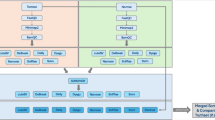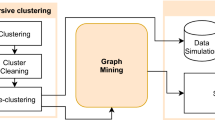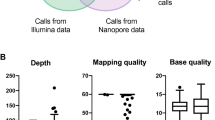Abstract
The development of high-throughput sequencing technologies has advanced our understanding of cancer. However, characterizing somatic structural variants in tumor genomes is still challenging because current strategies depend on the initial alignment of reads to a reference genome. Here, we describe SMUFIN (somatic mutation finder), a single program that directly compares sequence reads from normal and tumor genomes to accurately identify and characterize a range of somatic sequence variation, from single-nucleotide variants (SNV) to large structural variants at base pair resolution. Performance tests on modeled tumor genomes showed average sensitivity of 92% and 74% for SNVs and structural variants, with specificities of 95% and 91%, respectively. Analyses of aggressive forms of solid and hematological tumors revealed that SMUFIN identifies breakpoints associated with chromothripsis and chromoplexy with high specificity. SMUFIN provides an integrated solution for the accurate, fast and comprehensive characterization of somatic sequence variation in cancer.
This is a preview of subscription content, access via your institution
Access options
Subscribe to this journal
Receive 12 print issues and online access
$259.00 per year
only $21.58 per issue
Buy this article
- Purchase on SpringerLink
- Instant access to full article PDF
Prices may be subject to local taxes which are calculated during checkout



Similar content being viewed by others
References
Kandoth, C. et al. Mutational landscape and significance across 12 major cancer types. Nature 502, 333–339 (2013).
Frampton, G.M. et al. Development and validation of a clinical cancer genomic profiling test based on massively parallel DNA sequencing. Nat. Biotechnol. 31, 1023–1031 (2013).
Cibulskis, K. et al. Sensitive detection of somatic point mutations in impure and heterogeneous cancer samples. Nat. Biotechnol. 31, 213–219 (2013).
Puente, X.S. et al. Whole-genome sequencing identifies recurrent mutations in chronic lymphocytic leukaemia. Nature 475, 101–105 (2011).
Degner, J.F. et al. Effect of read-mapping biases on detecting allele-specific expression from RNA-sequencing data. Bioinformatics 25, 3207–3212 (2009).
Chen, K. et al. BreakDancer: an algorithm for high-resolution mapping of genomic structural variation. Nat. Methods 6, 677–681 (2009).
Rausch, T. et al. DELLY: structural variant discovery by integrated paired-end and split-read analysis. Bioinformatics 28, i333–i339 (2012).
Alexandrov, L.B. et al. Signatures of mutational processes in human cancer. Nature 500, 415–421 (2013).
1000 Genomes Project Consortium. An integrated map of genetic variation from 1,092 human genomes. Nature 491, 56–65 (2012).
Ye, K., Schulz, M.H., Long, Q., Apweiler, R. & Ning, Z. Pindel: a pattern growth approach to detect break points of large deletions and medium sized insertions from paired-end short reads. Bioinformatics 25, 2865–2871 (2009).
Wang, J. et al. CREST maps somatic structural variation in cancer genomes with base-pair resolution. Nat. Methods 8, 652–654 (2011).
Beá, S. et al. Landscape of somatic mutations and clonal evolution in mantle cell lymphoma. Proc. Natl. Acad. Sci. USA 110, 18250–18255 (2013).
Rausch, T. et al. Genome sequencing of pediatric medulloblastoma links catastrophic DNA rearrangements with TP53 mutations. Cell 148, 59–71 (2012).
Korbel, J.O. & Campbell, P.J. Criteria for inference of chromothripsis in cancer genomes. Cell 152, 1226–1236 (2013).
Gonzalez-Perez, A. et al. IntOGen-mutations identifies cancer drivers across tumor types. Nat. Methods 10, 1081–1082 (2013).
Baca, S.C. et al. Punctuated evolution of prostate cancer genomes. Cell 153, 666–677 (2013).
Shen, M.M. Chromoplexy: a new category of complex rearrangements in the cancer genome. Cancer Cell 23, 567–569 (2013).
Li, H. & Durbin, R. Fast and accurate short read alignment with Burrows-Wheeler transform. Bioinformatics 25, 1754–1760 (2009).
Richter, J. et al. Recurrent mutation of the ID3 gene in Burkitt lymphoma identified by integrated genome, exome and transcriptome sequencing. Nat. Genet. 44, 1316–1320 (2012).
Teles Alves, I. et al. Next-generation sequencing reveals novel rare fusion events with functional implication in prostate cancer. Oncogene 10.1038/onc.2013.591 (3 February 2014).
Huang, W., Li, L., Myers, J.R. & Marth, G.T. ART: a next-generation sequencing read simulator. Bioinformatics 28, 593–594 (2012).
Young, M.A. et al. Background mutations in parental cells account for most of the genetic heterogeneity of induced pluripotent stem cells. Cell Stem Cell 10, 570–582 (2012).
Jones, D.T. et al. Recurrent somatic alterations of FGFR1 and NTRK2 in pilocytic astrocytoma. Nat. Genet. 45, 927–932 (2013).
Wang, K., Li, M. & Hakonarson, H. ANNOVAR: functional annotation of genetic variants from high-throughput sequencing data. Nucleic Acids Res. 38, e164 (2010).
Untergasser, A. et al. Primer3–new capabilities and interfaces. Nucleic Acids Res. 40, e115 (2012).
Shaffer, L.G., McGowan-Jordan, J. & Schmid, M. (eds.) ISCN 2013: An International System for Human Cytogenetic Nomenclature (2013) (Kargar, 2013).
Krzywinski, M. et al. Circos: an information aesthetic for comparative genomics. Genome Res. 19, 1639–1645 (2009).
Acknowledgements
The ICGC-CLL Genome Consortium is funded by the Spanish Ministry of Economy and Competitiveness (MINECO) through the Instituto de Salud Carlos III (ISCIII), Red Temática de Investigación del Cáncer (RTICC) of the ISCIII (RD12/0036/0036) and National Institute of Bioinformatics (INB). This study was also supported by Ministerio de Economía y Competitividad, Secretaría De Estado De Investigación, Desarrollo e Innovación PLAN NACIONAL de I+D+i 2008-2011, Subprograma de Apoyo a Centros y Unidades de excelencia Severo Ochoa; and Plan Nacional SAF12/38432; Generalitat de Catalunya AGAUR 2009-SGR-992; Fondo de Investigaciones Sanitarias (PI11/01177); Association for International Cancer Research (12-0142). J.O.K. and M.S.W. were supported by the European Commission (Health-F2-2010-260791). C.L.-O. is an investigator of the Botin Foundation. E.C. and M.O. are ICREA Academia Researchers. We also thank S. Guijarro and C. Gómez for their excellent technical assistance.
Author information
Authors and Affiliations
Contributions
V.M., S.G. and D.T. conceived and designed the study. L.O.A., L.M., M.P., J.L.G., R.R. and M.O. performed data analysis. S.B., I.S., C.R., A.N., E.C. and I.G.G. generated and experimentally validated the MCL samples. M.S.-W., A.M.S. and J.O.K. generated and experimentally validated the MB1 sample. C.L.-O., X.S.P., E.C. and D.T. wrote the manuscript; and D.T. supervised the whole study.
Corresponding author
Ethics declarations
Competing interests
The authors declare no competing financial interests.
Supplementary information
Supplementary Text and Figures
Supplementary Figures 1–5 and Supplementary Tables 2 and 4 (PDF 4689 kb)
Supplementary Table 1 (XLSX)
List of somatic modifications affecting the in silico genome (XLSX 951 kb)
Supplementary Table 3 (XLSX)
Results of SMUFIN and others methods for the in silico validation analysis (XLSX 5687 kb)
Supplementary Table 5 (XLSX)
Results of SMUFIN on the Mantle Lymphoma M004 (XLSX 773 kb)
Supplementary Table 6 (XLSX)
Validation sequences of M003 lage structural variants. The identifyiers shown here correspond to the ones of Supplementary Table 8. (XLSX 23 kb)
Supplementary Table 7 (XLSX)
Results of SMUFIN on the Medulloblastoma MB1 (XLSX 208 kb)
Supplementary Table 8
Results of SMUFIN on the Mantle Lymphoma M003 (XLSX 194 kb)
Supplementary Source Code
Compressed ZIP file with SMUFIN's source code (ZIP 1659 kb)
Rights and permissions
About this article
Cite this article
Moncunill, V., Gonzalez, S., Beà, S. et al. Comprehensive characterization of complex structural variations in cancer by directly comparing genome sequence reads. Nat Biotechnol 32, 1106–1112 (2014). https://doi.org/10.1038/nbt.3027
Received:
Accepted:
Published:
Issue date:
DOI: https://doi.org/10.1038/nbt.3027
This article is cited by
-
Ultrafast prediction of somatic structural variations by filtering out reads matched to pan-genome k-mer sets
Nature Biomedical Engineering (2022)
-
GeDi: applying suffix arrays to increase the repertoire of detectable SNVs in tumour genomes
BMC Bioinformatics (2020)
-
High throughput barcoding method for genome-scale phasing
Scientific Reports (2019)
-
CLOVE: classification of genomic fusions into structural variation events
BMC Bioinformatics (2017)
-
Transposase-driven rearrangements in human tumors
Nature Genetics (2017)



